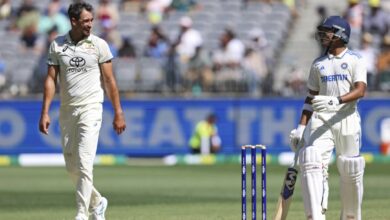Great mover, strong defence, steady baseliner: How Sumit Nagal embraced clay court game despite being from the subcontinent | Tennis News

In October 2022, bogged down injuries and struggling to put wins together while grinding it out on the lower-rung Challenger Tour, Sumit Nagal’s ranking had slipped outside the top 500.This week, shortly after a first-round defeat at the ATP event in Geneva, 26-year-old Nagal, now a top 100 player at the peak of his powers preparing for his first appearance at the French Open – the only Major that takes place on his preferred surface of clay – was contacted Novak Djokovic’s team for a practice session.
Solid practice before Roland Garros
Thank you, @DjokerNole 💪🏽 pic.twitter.com/lNa2pbz1Ih
— Sumit Nagal (@nagalsumit) May 21, 2024
Nagal’s year-and-half-long journey from injury-induced obscurity and uncertainty, to being sought out the greatest player in the hory of his sport for a training session, illustrates both the revival of his once-promising career, and the lonely battle he continues to wage as the only consent Indian presence in top-level singles tennis.
Prior to his injury trouble, Nagal’s promise as a young player coming through the ranks was evident in his previous appearances at the Majors (even winning a set off Roger Federer at the 2019 US Open). Meanwhile, during his slump, no Indian player even qualified for the main draw at a Grand Slam singles tournament for three years until he recovered and did so himself, at this year’s Australian Open, where he seized a rare chance to make national headlines becoming the first Indian to beat a seeded player at a Major since Ramesh Krishnan did so in 1989.
Sumit Nagal of India celebrates after defeating Alexander Bublik of Kazakhstan in their first round match at the Australian Open tennis championships at Melbourne Park, Melbourne, Australia. (AP | PTI)
Since then, Nagal has been on the up, winning a Challenger event in Chennai and then making main draws of top tournaments – recently even becoming the first Indian to win a main draw match of a Masters 1000 event on clay in Monte Carlo, where he took World No. 13 Holger Rune to three tough sets.
During the years Nagal spent on the sidelines, he needed to believe he would return to competing in the biggest tournaments in the world to keep going. “I knew this (time) would come,” he tells The Indian Express. “This was my biggest motivation because when you are injured, you have to look towards (a goal) and have some vision otherwise it gets too hard.”
Nagal goes into the French Open, starting Sunday, and Wimbledon next month, confident and in good form, hoping to put a run together.
Best on clay
While impossible to speculate, perhaps Nagal may not have been sought out Djokovic’s team had the French Open not been coming up. The Indian’s best surface is clay, which allows him to nullify some of the weaknesses that come with his short stature, not allowing him to launch big first serves or generate easy power.
Instead, it is in his fast movement and solid defence, where Nagal excels as primarily a baseliner. Clay does not reward the power game as much as hard courts and grass, and allows Nagal to slide around and give him that extra time to get balls back into play.
“He’s a great mover,” Sania Mirza says during a media interaction. “Usually, as people from the subcontinent, that has not been our forte. Clay has not been the favourite surface of the players that come out of this region. But his movement, his style of play, his defence make him the toughest to face on clay. He’s the most comfortable moving on that surface.”
Sumit Nagal of India celebrates after defeating Alexander Bublik of Kazakhstan in their first round match at the Australian Open tennis championships at Melbourne Park, Melbourne, Australia. (AP | PTI)
Each of Sumit’s three Challenger titles outside of India have been on clay. Naturally then, after making a breakthrough in Monte Carlo in April, Nagal was expected to ride the momentum and improve his ranking even further, but instead had to take another break to nurse injury concerns.
Somdev Devvarman, a former top 70 player, has worked with Nagal as a mentor and coach. He explains how the 26-year-old’s playing style – of relentless defensive grind from the baseline – helps him on clay, but also tends to make him injury prone.
“These kinds of (injury) cycles will continue with a player like Sumit simply because he has to work incredibly hard to win points,” Devvarman tells The Indian Express. “He’s a smaller guy on the tour. So he has to work incredibly hard to win points. When he’s feeling great, he’s very, very tough to play. When he’s a little off, sometimes players feel like they can get on top of him, maybe get on top of his serve.”
Crucial top 100 spot
Nagal’s injury prone streak has often stopped him from sustaining momentum and surging up the rankings to take the next step in his career. One of the many peculiarities of tennis is the importance of the ruthless 12-month-long rolling rankings system, determining everything from playing and prize money opportunities to chances of sponsorships and exposure.
While his Australian Open run garnered the most attention, what has been most impressive about Nagal’s 2024 season so far is his consency – doing well in Challengers and qualifying for ATP tournaments in order to crack the top 100 in the rankings and momentarily stay there.
India’s Sumit Nagal shakes hands with Kazakhstan’s Alexander Bublik after winning his first round match. (Reuters)
Being in the top 100 carries heavy significance because it ensures qualification to the main draw of the four Majors that present earning opportunities that can sustain players for an entire year. Even if Nagal loses his first-round match at Roland Garros this week, he would have earned Rs 1.6 crore just through his run at the Australian Open and in Paris. For a player who complained of having only Rs 80,000 in his bank account last October, that’s a huge number.
But being in and around the top 100 spots is one thing, making up a permanent place there is a lot trickier.
“The margin between making, say, $200,000 and $50,000 is very small. It’s just based on rankings and, you know, you play two slams and you’ve made $100,000. And you’ve lost two final rounds of qualifying and you’ve made 50,” Devvarman says.
“A lot of it is timing based, luck based on injuries and things like that. It’s a very fine line between being World No.55 and World No.95. In terms of staying in the top 100, ultimately, it always comes down to what your level is. What are the things that are pushing your level? What are the things that you’re improving every day? And the next time you step on the court, can you bring that level back?”
Devvarman also inss that, while doing well at lower-level tournaments can maintain the desired ranking, all players dream bigger. “I think for all of our tennis players, yeah, we want to win Challengers and all of that, but ultimately you want to do well at the biggest events in the world,” he says.
Doing so at the French Open will be a tall order, and represents the next big hurdle. Unseeded players are at the mercy of the draw at tennis tournaments, and Nagal has been placed to face 18th seed and last year’s quarterfinal Karen Khachanov in the first round this week.
But for Nagal to take the next step, his coach believes he must get these crucial wins and go on a run in one of these tournaments, and that “if you look at his results from last year, you still think that he is in a great spot to make a run pretty much any time now.”
Don’t expect a pattern
Nagal’s recent achievements, modest but encouraging, may not have been of a world-beating standard, but they have been celebrated fans of a substantially popular sport, longing to watch it through an Indian lens.
While Nagal’s 2024 season has ended a long, drawn-out period of apathy among Indian tennis fans, there are no indications that it will light a spark for up-and-coming players with the deeper malaise in Indian tennis persing.
Nagal’s is a truly unique case. Born in Jhajjar to a schoolteacher, he was spotted and supported in his early years former Indian veteran Mahesh Bhupathi. He spent his formative years training in Canada, then moved to Germany where he is currently based, training at his coach Sascha Nensel’s academy.
India’s Sumit Nagal defeated former World No 38 Alex Molcan to enter the Australian Open main draw. (PHOTO: Australian Open X)
Good timing, generous benefactors and peaking at the right time as a junior all enabled Nagal’s development, and even then he has faced significant financial strife. Not everyone will get the same chances.
“The first advice you would give a good kid that’s from India, would be to put yourself in a better environment,” Devvarman says. “The system in India is a joke, right? It’s just not conducive to player development. And because it’s not conditioned to player development, it’s the reason why every player wants to leave.”
“Sadly, the right people that young players in this country will be looking for are not in the right places. So right now, if a promising young kid and their family are really looking for advice or help, they’ve got to do it the way everybody else has done it – on their own. Figure it out themselves.”
With the current systems in place, there remains little hope for India to produce players that will play on the same stage as consently as Sumit has been recently. So hope, then, will be transferred to the 26-year-old to make the best of those chances.
(The French Open starts on Sunday, May 26, live on the Sony Sports Network)







